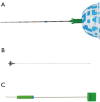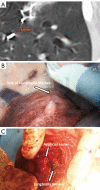Augmented reality navigation-guided pulmonary nodule localization in a canine model
- PMID: 35004246
- PMCID: PMC8674612
- DOI: 10.21037/tlcr-21-618
Augmented reality navigation-guided pulmonary nodule localization in a canine model
Abstract
Background: The current intraoperative pulmonary nodule localization techniques require specific medical equipment or skillful operators, which limits their widespread application. Here, we present an innovative nodule localization technique in a canine lung model using augmented reality (AR) navigation.
Methods: Peripheral pulmonary lesions were artificially created in canine model. A preoperative chest computed tomography scan was performed for each animal. The acquired computed tomography images were analyzed, and an established intraoperative localization plan was uploaded into HoloLens (a head-mounted AR device). Under general anesthesia, lung localization markers were implanted in each canine, guided by the established procedure plan displayed by HoloLens. All artificial lesions and markers were removed by video-assisted wedge resection or lobectomy in a single operation.
Results: Since June 2019, 12 peripheral pulmonary lesions were artificially created in 4 canine models. All lung localization markers were precisely implanted with a median registration and implantation time of 6 minutes (range, 2-15 minutes). The average distance between pulmonary lesions and markers was 1.9±1.7 mm, based on computed tomography examination after localization. No severe pneumothorax was observed after marker implantation. After an average implantation period of 16.5 days, no marker displacement was observed.
Conclusions: The AR navigation-guided pulmonary nodule localization technique was safe and effective in a canine model. The validity and feasibility of using this technology in patients will be examined further (NCT04211051).
Keywords: Augmented reality (AR); animal study; intraoperative nodule localization; navigation.
2021 Translational Lung Cancer Research. All rights reserved.
Conflict of interest statement
Conflicts of Interest: All authors have completed the ICMJE uniform disclosure form (available at https://dx.doi.org/10.21037/tlcr-21-618). The authors have no conflicts of interest to declare.
Figures







Similar articles
-
Augmented reality navigation-guided intraoperative pulmonary nodule localization: a pilot study.Transl Lung Cancer Res. 2023 Aug 30;12(8):1728-1737. doi: 10.21037/tlcr-23-201. Epub 2023 Aug 4. Transl Lung Cancer Res. 2023. PMID: 37691871 Free PMC article.
-
[Clinical Application of Vectorial Localization of Peripheral Pulmonary Nodules Guided by Electromagnetic Navigation Bronchoscopy in Thoracic Surgery].Zhongguo Fei Ai Za Zhi. 2019 Nov 20;22(11):709-713. doi: 10.3779/j.issn.1009-3419.2019.11.05. Zhongguo Fei Ai Za Zhi. 2019. PMID: 31771740 Free PMC article. Chinese.
-
[Computed Tomography Guided Hook-wire Precise Localization and Minimally Invasive Resection of Pulmonary Nodules].Zhongguo Fei Ai Za Zhi. 2015 Nov;18(11):680-5. doi: 10.3779/j.issn.1009-3419.2015.11.04. Zhongguo Fei Ai Za Zhi. 2015. PMID: 26582223 Free PMC article. Chinese.
-
Video-assisted thoracoscopic solitary pulmonary nodule resection after CT-guided hookwire localization: 43 cases report and literature review.Surg Endosc. 2011 Jun;25(6):1723-9. doi: 10.1007/s00464-010-1502-3. Epub 2010 Dec 22. Surg Endosc. 2011. PMID: 21181200 Review.
-
Precise sublobar lung resection for small pulmonary nodules: localization and beyond.Gen Thorac Cardiovasc Surg. 2020 Jul;68(7):684-691. doi: 10.1007/s11748-019-01232-1. Epub 2019 Oct 25. Gen Thorac Cardiovasc Surg. 2020. PMID: 31654291 Review.
Cited by
-
Augmented reality navigation-guided intraoperative pulmonary nodule localization: a pilot study.Transl Lung Cancer Res. 2023 Aug 30;12(8):1728-1737. doi: 10.21037/tlcr-23-201. Epub 2023 Aug 4. Transl Lung Cancer Res. 2023. PMID: 37691871 Free PMC article.
-
Combined indocyanine green and medical glue enables stable and precise position in animal studies: promising for fluorescence-guided pulmonary ground glass nodule resection.Transl Lung Cancer Res. 2023 Sep 28;12(9):1923-1934. doi: 10.21037/tlcr-23-553. Epub 2023 Sep 25. Transl Lung Cancer Res. 2023. PMID: 37854160 Free PMC article.
-
A new technology for a novel clinical approach in a dog with a complex vascular anomaly: the "extended reality".Vet Res Commun. 2025 Feb 7;49(2):100. doi: 10.1007/s11259-025-10668-1. Vet Res Commun. 2025. PMID: 39918737 Free PMC article.
-
Is Overlain Display a Right Choice for AR Navigation? A Qualitative Study of Head-Mounted Augmented Reality Surgical Navigation on Accuracy for Large-Scale Clinical Deployment.CNS Neurosci Ther. 2025 Jan;31(1):e70217. doi: 10.1111/cns.70217. CNS Neurosci Ther. 2025. PMID: 39817491 Free PMC article. Review.
-
State of the Art and Future Prospects of Virtual and Augmented Reality in Veterinary Medicine: A Systematic Review.Animals (Basel). 2022 Dec 13;12(24):3517. doi: 10.3390/ani12243517. Animals (Basel). 2022. PMID: 36552437 Free PMC article. Review.
References
Associated data
LinkOut - more resources
Full Text Sources
Other Literature Sources
Medical
Research Materials
